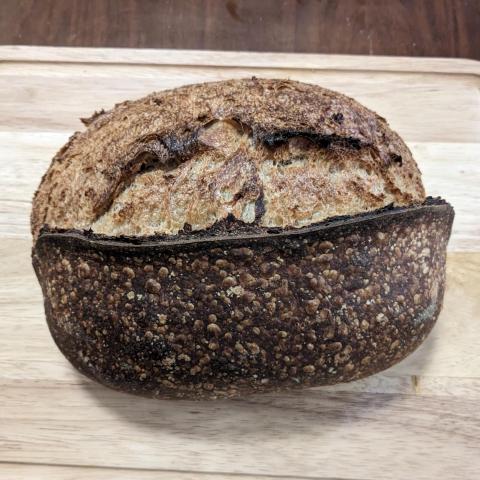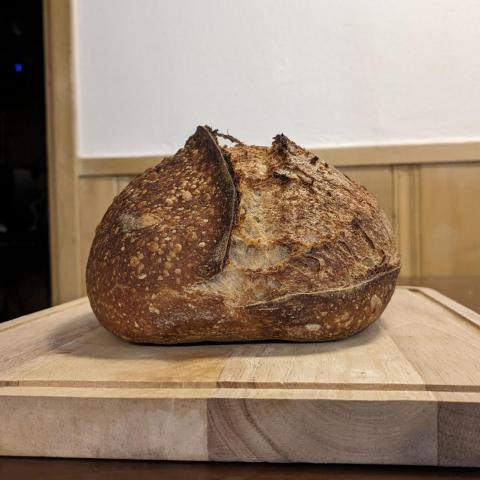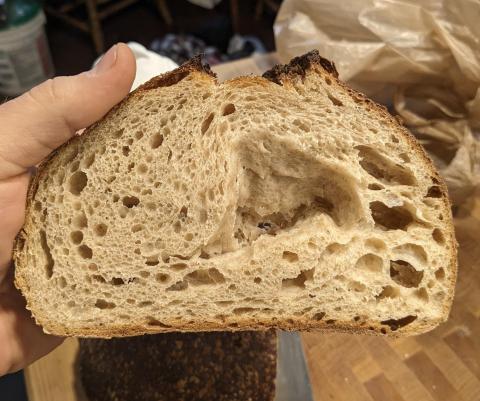
why does this keep happening to me

The past few months, I've been using a lot of high extraction and whole wheat flour (both freshly milled), which has been working really well for me. However, occasionally I still make white or mostly white loaves, mostly for convenience. This past Saturday I got back from a work trip in the morning and wanted to make sure we had fresh bread by Sunday night, so I refreshed my starter and mixed up the following dough:
- 300g whole (hard red) wheat flour
- 690g white flour (mostly all purpose, with a little KA bread flour I had left over)
- 10g vital wheat gluten
- 64g 50% hydration starter
- 21g salt
- 750g water
The dough felt great. I gave it a couple of stretch and folds and let it bulk rise for 12 hours. Volume increase was 75-100% before I split it in half and shaped it. I let it sit at room temp for 40 minutes before putting it in the fridge to retard for another 12 hours, then baked it in a preheated dutch oven straight from the fridge.
I was super pleased with the crust, color, and spring on this loaf, but when I cut into it I found a massive cavern. This also happened the last couple of times that I baked with white flour, but it doesn't happen when I use exclusively fresh milled flour.
What's going on here? Is it a proofing problem? I don't see any obvious signs of over- or underproofing. Is it a shaping problem? Do I need to degas more? It didn't seem like there was a significant bubble anywhere in the dough when I shaped it.





It's not a proofing problem. I don't know what the dough felt like, but it looks like it was too dry so that when you folded or rolled the dough during shaping, it didn't bond completely with itself at some places. If not overly dry, it may be that you didn't apply enough pressure in that area during shaping. The pocket was probably forced apart by gas that came out of the dough during baking. You can pretty well see that just from the shape of the pocket.
It's basically a darned good-looking loaf so correcting the problem shouldn't be hard.
TomP
Looks like a shaping issue.
I barely use any flour during the final shape (none during pre-shaping), but maybe 30 minutes uncovered is too long with the ambient humidity where it's at right now. I hadn't really thought about making sure the roll adheres all the way around, thanks!
I wouldn't leave it uncovered during the rest between pre-shaping and final shaping. Once the surface dries out too much, it will be almost impossible to get it to bond right during shaping.
I also think it’s a shaping problem. When you shape the loaf, do you put a lot of flour on the bench to prevent sticking? Too much flour could cause this.
-Brad
I don't flour the bench at all during shaping. I pre-shape without any flour, then I put a very small amount (maybe 1/2 tsp per loaf at most) on the top of each "boule" before flipping it over and shaping it into a batard. The top might get pretty dry just from being uncovered from 30 minutes, but the other side should still be quite moist.
...thin crust, nice crumb (other than the cavern). This all points to good fermentation. Only thing left is shaping! Pop those big bubbles and try not to get any flour (or water if that's what you're using on your hands to not make the dough stick) inside the dough which can create pockets.
P.s. after having a closer look that gap is in the roll when you shaped the dough. You must have introduced an air bubble somehow.
Nice one - I never thought of water on the hands.
I guess I could see how an air bubble could be introduced as I start the roll, I'll focus next time on creating a good seal from the start. It's just funny to me that this only happens on mostly white doughs.
Degas the loaf by patting it to deflate the bubbles after bulk ferment. After fully degassing and deflating bubbles, form and proof.